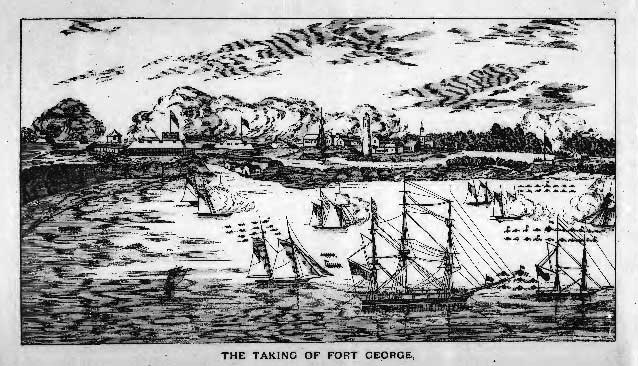While one commander’s star would fall, another’s rose to prominence as American Colonel Winfield Scott mounted a brilliant amphibious operation against Fort George at the mouth of the Niagara River.

The Battle of Fort George from the Philadelphia Portfolio, 1817 Archives of Ontario Photographic Collection
Hidden by fog on the morning of May 27th, 1813, ships carrying American soldiers left Fort Niagara in New York. They crossed the mouth of the Niagara River and landed on the opposite shore in Upper Canada. Their aim was to capture the town of Niagara and nearby Fort George from the British as part of a campaign to invade Upper Canada.
The American commander, General Henry Dearborn, hoped to secure victory by combining a naval bombardment with overwhelming numbers of landing troops. On May 25, American batteries unleashed a barrage intended to break down British resistance. Gunners employed hot shot—cannonballs heated red-hot in furnaces—and burned down some of the wooden structures in the British fort.
Two days later, under covering fire from the ships, light infantry led by Colonel Winfield Scott began landing on the beachhead. The British commander—outnumbered four to one, and facing attack from several directions at once—decided to evacuate the fort rather than risk being surrounded. With the British on the run, American soldiers quickly captured the town and fort. For a time, the invasion of Upper Canada looked promising indeed, with only minor losses on the American side.
But through months of delay and indecisiveness, General Dearborn squandered his good fortune by failing to follow up his initial success. British forces eventually recaptured Fort George as well as the Americans’ Fort Niagara. Together, those forts controlled the mouth of the Niagara River, a vital anchorage for any ships bound for the western part of Lake Ontario. It remained in British hands for the remainder of the war.
Dearborn was eventually recalled for his ineffectual command. But in a war full of incompetent commanders, Winfield Scott’s performance at Fort George had proved an exception. Scott earned promotion and accolades as a rising star for his planning and execution of one of the most brilliant actions of the war.
Last updated: March 5, 2015
